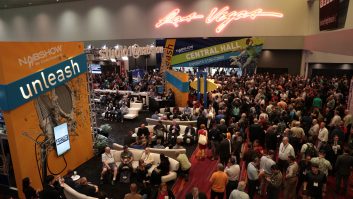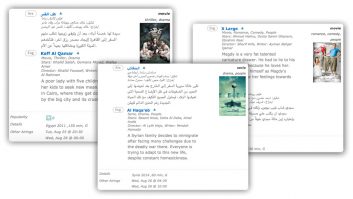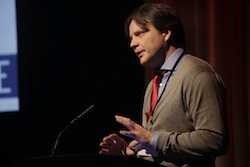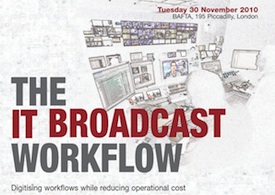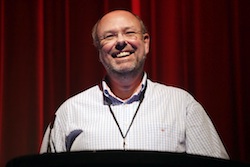
IT Broadcast Workflow 2010: Discovery Communications Europe, How language barriers have made IT-based workflow necessary; facing problems with reporting and meeting metadata requirements.
Discovery had a need to introduce efficiencies to its existing set-up operating multiple channels and languages. As a result a revamp of its playout and production facilities took three years — although it was deliberately planned in small phases so as not to harm transmission in any way.
Introducing the presentation, Tony Taylor, chairman and CEO of video over IP solutions vendor TransMedia Dynamics (TMD) agreed that a one-size-fits-all asset management system wasn’t viable.
“Anyone who thinks a single MAM system can go in the same in every operation is deluding themselves,” he said. “They are different even for the same company.”
The reason, he explained, was that there has to be a different approach to project development. “Discovery’s production facility [in Silver Spring, Washington] was allowed to go in parallel into existing operations. The problem with the playout operation at Chiswick Park was that it was an on-air system operating 24/7 that could not go offline. Although both workflows and metadata are now linked, the challenges we faced with these two projects were completely different.”
Taylor further agreed that broadcasters may have unrealistic expectations but so do operators in terms of the functionality they expect. “The comments I normally receive are ‘but we’ve always done it that way’ or ‘well it’s just software isn’t it?’” Taylor noted. “There’s an education and change management aspect of moving to IT which systems integrators and vendors have to get across.”
Concentrating on the Chiswick Park installation David Roulson, Discovery’s director, Broadcast Engineering (pictured), explained that the group operated 120 networks worldwide in over 40 languages.
“It’s the language barrier which is a significant part of why we needed some IT-based workflow to cope with increased demands on our existing system,” he said.
Discovery Europe distributes content as far east as Russia and the Ukraine down to Africa and the Middle East. “Unlike the US or Latin America where there’s saturation coverage in one main language, the multiple languages of EMEA do give us dreadful problems.”
Chiswick Park plays out 61 channels in 20 audio languages totalling 1,400 hours of content every 24 hours. “That’s a considerable amount of content preparation,” Roulson said. “It’s fair to say that the broadcast facility we used before worked well, but it needed to be improved.”
The main operational challenge was to move away from a system requiring three disparate data entry points for scheduling/traffic systems; transmission/ingest system and for asset management.
“Our operators were faced with having to learn three different systems, input three sets of data into three different interfaces and to do so correctly all of the time,” Roulson explained.
Since Discovery’s assets predominately arrive as English language it can take 8-12 weeks for them to be returned by language houses for versioning before adding into the system. “During that period content that’s received as a first or second language may be required for transmission so we need to take an on-air product back into the ingest process, adding the necessary languages and returning it back so it can continue to be transmitted.”
With multiple audio languages arriving at different stages and with different user interfaces at different points in the chain, this orchestration was getting overly complicated. The ability to recall assets and add new languages was a growing concern, particularly as plans for new languages were being cooked.
There was also a problem in reporting. “We were having to look at three different systems to check status and viability,” he said. “Reporting began on a manually written piece of paper containing media ID and information about the asset saying it had been through certain processes. That paperwork was presented to a manager who compiled an XLS spreadsheet — which as a metric is time consuming and not exactly the best way to move a business forward.
“We also needed to make the metadata model adaptable for the future which might mean post production or 3D. We don’t know what we will need but we knew we needed flexibility built-in.”
Discovery required metadata in a format that everybody could understand and visualise — a standardised format with the UI known by every operator.
TMD supplied Discovery with Mediaflex, an integrated MAM and workflow product which enabled the broadcaster to move data transparently back and forth between existing business management software Pilat and asset management system Artesia into Isilon and Front Porch Diva storage and archives and between international locations.
“There were significant challenges,” underlined Roulson. “Anybody who feels they want a MAM or some form of IT-based workflow may not fully understand exactly what they want when they start — so taking it in slow baby steps meant we were able to make those changes without having a system that went live and then scrapping it. That took input from the operations team, engineering and the business side.”
The core of the architecture is a Mediaflex MetaServer which provides for all information and reporting for all metadata.
“The good, solid broadcast infrastructure we had has now been combined with an umbrella system that gives us a standards-based environment that the user can work with,” Roulson said. “We can define and build workflows and change them depending on new equipment or business needs and operators can now do that with one graphical interface accessed at any point in the workflow. A GUI presented as a box to box with an arrow is easier than reading some xml text flow. Once operators are presented with something they understand they are much more likely to do a better job.”
The ability to QC has been enhanced. With each asset averaging 28-30 audio files the ability to shuffle tracks while QC-ing was a key criteria. Being able to monitor the status of an asset in terms of its metadata and content essence was also imperative.
“We can pass all the information from our broadcast systems back to the business so that they can make more efficient business decisions,” said Roulson. “New, dynamic workflows means we can react to the needs of the business as required. Every now and then you get a request which is extremely off the wall but you need to be able to cope with it.”
New audio processes permit more confident monitoring and a reduction in on-air errors. “We can now report the status of assets throughout all our systems globally, with errors flagged up in terms of content and metadata movement. Globalised metrics means we can grow the business and move in new directions much more efficiently.”
Declining to divulge the cost of the installation, Roulson expressed satisfaction that ROI was being met. “Having different systems meant we were prone to errors which could effect scheduling and potentially TX. For example, when operators are manually adding a language at 3am then POL [Poland] and POR [Portugal] don’t look that different but if there’s a mix it can clearly create problems down the line. Our new standardised, streamlined approach definitely reduces those commercially risky errors.” – Adrian Pennington




